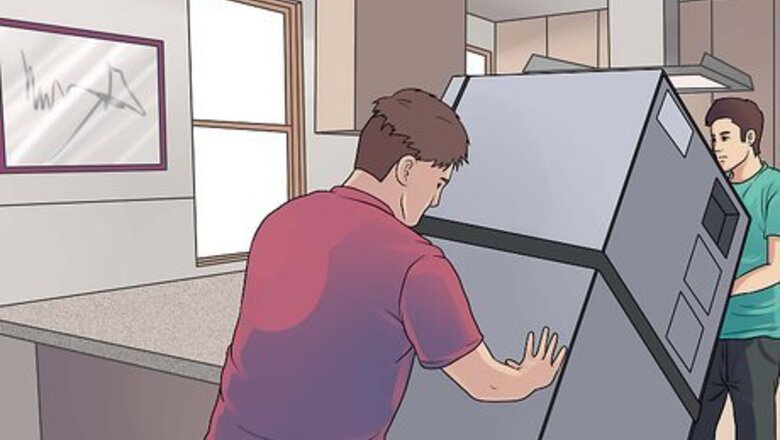
views
Measuring Width

Move the refrigerator. To get many of the right measurements, you should move the refrigerator to allow access to the space. When doing so, be sure to remove everything in the refrigerator and have at least one strong person around to assist you. Do not leave any shelves in the refrigerator that can be jostled during the moving process. Either take the shelves out and move them separately or use tape to secure them. Be sure that the doors don't open up while you move the refrigerator. Take a strap and tie it around the doors or wrap tape around them. Don't ever lay a refrigerator on its side.

Measure the space of the opening. It might be tempting to measure the size of your current refrigerator. But it is possible that the refrigerator is not the optimal size for the space. Begin by measuring the open space where you will put the refrigerator.
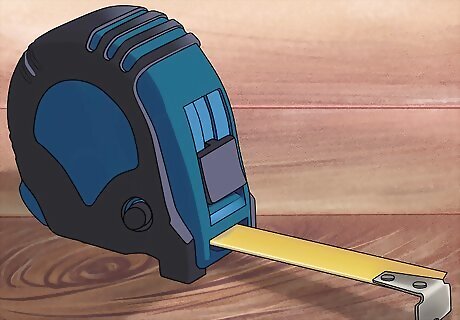
Use a retractable measuring tape. Place one end against the wall. Extend the tape to reach to the opposite end of the open space. Mark the measurement on the tape with a pencil. Write down the measurement on a separate sheet of paper.
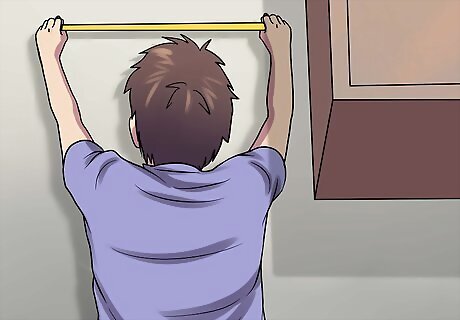
Repeat the measurement. Not only is it possible that you misread the tape measure, it is also possible that your house has settled. In the process, some of the surfaces might become uneven. Repeat the measurement at a different point in the open space. If there is a discrepancy, use the smaller measurement. It is better to have too much space, not enough.

Pick a store model that will allow you extra space. You will want at least an inch of additional space on both ends of the refrigerator so that you have space to clean dust off the sides of it. However, you will also want at least two inches on any side that has a door hinge, so that have space to fully open and close the refrigerator.
Measuring Height

Move the refrigerator. To get some of the measurements, you will need to move the refrigerator. When doing so, be sure to remove all the food in the refrigerator. Get at least one strong person to help you. Do not leave any shelves in the refrigerator. These can be jostled during the moving process. Either take the shelves out and move them separately or use tape to secure them in place. Be careful that the doors do not open when you move the refrigerator. Either take a strap and tie it around the doors or wrap tape around them. When moving a refrigerator, don't lay it on its side. This can cause serious damage to the refrigerator.

Ask for help when measuring height. You might need the assistance of a second person to secure the tap at the top of the space, while you pull it down to the bottom and record the measurement. You might also need the assistance of someone taller than yourself. It is helpful to have a second person around, if possible. Alternatively, hang the metal hook at the top of the tape measure on whatever surface is available near the top of the space. Pull the tape measure down to get your first measurement. Then measure the distance from the top of the space to the overhang from which the tape measure was hanging. Add this distance to the first measure to get the total height.

Extend the retractable measuring tape about a foot. That way, the tape will reach a height that is taller than you.
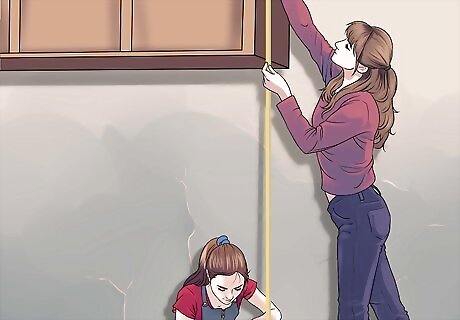
Hold the top of the tape against the cabinet. Have a second person pull the measuring tape to the ground. Mark the end point on the tape measure then write the number down on a paper pad with the other measurements.
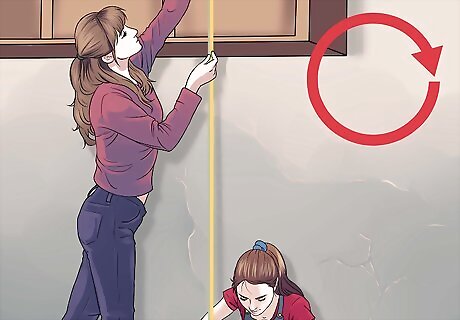
Repeat the measurement. Not only is it possible that you misread the tape measure, it is also possible that your house has settled. In the process, some of the surfaces might become uneven. Repeat the measurement at a different point in the open space. If there is a discrepancy, use the smaller measurement. It is better to have too much space, not enough.

Pick a model that allows for at least one inch of open space. Refrigerators require ventilation to work properly. There must be at least one inch of space remaining above the refrigerator.
Measuring Depth

Move the refrigerator. To get many of the measurements, particularly dept, you will need to move the refrigerator. When doing so, be sure to remove everything in the refrigerator and have at least one strong person on hand to assist you. Do not leave any shelves in the refrigerator that can be jostled during the moving process. Either take the shelves out and move them separately or use tape to secure them in place. Be sure that the doors don't open up while you move the refrigerator. Either take a strap and tie it around the doors or wrap tape around them. When moving a refrigerator, don't ever lay it on its side.

Measure from the back of the space to the front of the counter. Place the measuring tape against the back of the available space. Extend the tape out to the front of the counter. Write down the number on the measuring tape.
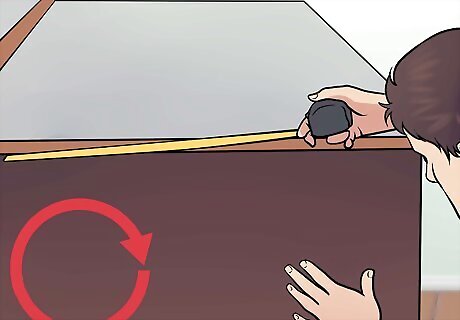
Repeat the measurement. Not only is it possible that you misread the tape measure, it is also possible that your house has settled. In the process, some of the surfaces might become uneven. Repeat the measurement at a different point in the space allotted for the refrigerator. If there is a discrepancy, use the smaller measurement. It is better to have too much space, not enough.
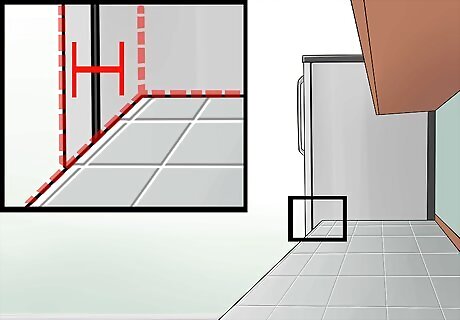
Decide if you want the refrigerator to extend past the counters. If you have not allotted two additional inches on the side for the door hinges, you will need to move the refrigerator two inches out from the counter space to give the doors room to open. This will allow you more room for depth, but you will need to verify that the doors do not extend too far out into the room.
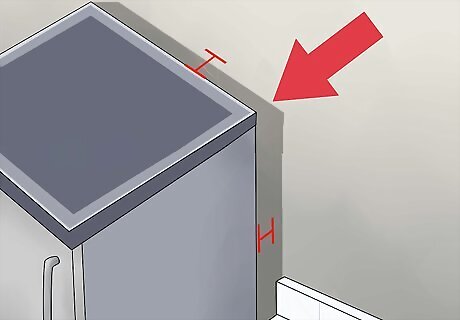
Allow at least an inch of space behind the refrigerator. Refrigerators require ventilation to work properly. There must be at least an inch of space remaining behind the refrigerator.
Finding the Perfect Fit

Check the height and width of your smallest doors. Having enough space for a refrigerator won’t amount to much if you can’t get it through the door. Determine what path you will use bring the refrigerator into your home. Compare the size of the doorways to determine that there is sufficient space to get the refrigerator in.
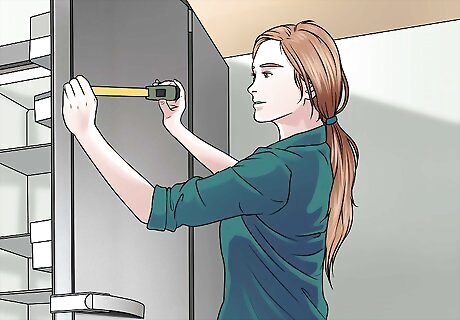
Check the length of the doors. Many refrigerator models don’t advertise the door measurements. At the store, open the doors to a 90 degree angle and measure from the back of the refrigerator to the end of the doors. At home, take the measuring tape and see how far the doors would open into your kitchen. Start from where the back of the fridge would be located, at least an inch from the wall, and measure out the combined length of the depth of the fridge and the length of the doors. If you need to move the refrigerator out past the end of the counter to accommodate the hinges of the door, you might be required to adjust your measurements. Start from two inches past the counter. Measure back to the wall the depth of the refrigerator. That point will be where the back of the refrigerator rests. From that point measure outward, the depth of the refrigerator plus the length of the door. That will be the length that the door extends into the room. Once you know how far the door will open up into the room, ask yourself if that is acceptable. Will there be enough room to open the door entirely without hitting a counter? Will the open door block a pathway in the kitchen or make things uncomfortably tight? If the door does extend too far, consider an alternative model. Refrigerators with French doors and side-by-side doors will not open out as far into your kitchen.

Find a model that has sufficient storage space. How much storage space you need will vary depending upon the size of your household and your eating habits. You should allot at an absolute minimum 4-6 cubic feet of space for each adult using the refrigerator. On average, a couple that does not eat frequently at home should aim for 12-16 cubic feet of refrigerator space. A couple that does cook frequently should have at least 18 cubic feet of space. A family of four should generally have at least 20 cubic feet of space. Also account for what type of space you need. Are you more prone to eat frozen foods or fresh vegetables? Find a model that allots space in a way consistent with your dietary habits.

















Comments
0 comment